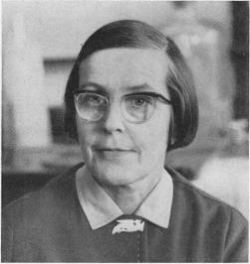Mary Barber

- Born
- 3 April 1911
- Died
- 11 September 1965 (age 54)
Mary Barber was a British bacteriologist who led the field of research in antibiotic resistance. She was the fifth generation in a long line of family members to study medicine and was a prominent female figure in the field of pathology.
Much to her father's pride, Barber followed in his steps to study medicine. In 1928 she attended the London school of Medicine for Women, the first medical school in Britain to train women. Following her graduation she held many clinical posts, including House Physician at the Royal Free Hospital and went on to study for a postgraduate degree and publish a number of research papers.
In 1947, while working at the Hammersmith Hospital on London, she noted the resistance of some bacteria to penicillin. Staph infections, caused by the Staphylococci bacteria, were being treated with penicillin which was quickly becoming ineffective against the infection. Barber was the first to recognize that this resistance was due to rise in the number of a small minority of cells capable of producing an enzyme that destroyed penicillin.
In 1948 Barber was appointed reader in bacteriology at St Thomas's Hospital, London, from where she conducted comprehensive studies of cross-infection. She proposed a programme of preventive measures, notably a policy that required the use of combining various antibiotics together to best fight infection. She was invited back to Hammersmith in 1958 where her research culminated in a substantial decline in the prevalence of antibiotic resistance. She was rewarded with the title of professor in 1963 and membership of the Royal College of Physicians in 1965.
Although Barber's work was rooted in the hospital ward, it was underpinned by a grasp of microbial biochemistry and genetics that allowed her to collaborate with colleagues specialising in research. She was intensely interested in the development of man-made penicillin that would be effective against resistant bacteria and was among the first to have new antibiotics made available to her for independent assessment. This led to an invitation to write a comprehensive account of antibiotics and their clinical use. She was joined by L. P. Garrod, and the book Antibiotic and Chemotherapy was published under their joint names in 1963.
Barber had strong views and became a fluent, forceful, and sometimes funny speaker. Wherever she attended meetings around the world she was instantly recognizable by her slight figure, glasses, clipped back hair and utilitarian clothes. She was a good teacher but was principally absorbed in her work at the bench, where associates recall equally vividly her sharp tongue and her kind heart.
Barber never married, and for most of her life she lived in a flat in London. She died on 11 September 1965at the age of 54 in a road collision while travelling to a Campaign for Nuclear Disarmament meeting. Throughout her life Barber possessed strong political and religious beliefs, as a firm political liberal and devout Anglican.



